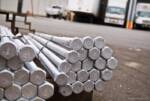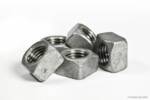Galvanizing Bolts FAQs

Galvanized Coating Lifespan
What is the life span of the hot-dip galvanized coating of a bolt?A common question when deciding whether hot-dip galvanizing is an adequate corrosion resistant coating for a fastener is, “How long will the galvanizing last before the steel begins to corrode?” The last thing you want to do is install a bolt in a corrosive environment, only to have it begin to rust a year later. Unfortunately... Read more
Overtapping Mechanically Galvanized Nuts
What are the overtapping allowances for mechanically galvanized nuts?The overtapping allowances for mechanically galvanized nuts are the same as overtapping allowances for nuts that are hot-dip galvanized. Mechanically galvanized nuts that adhere to ASTM B695 are “cold-galvanized,” which implies that they are coated with zinc at room temperature. Neither electricity (electroplate galvanizing) nor heat (hot-dip galvanizing) are applied in a mechanically galvanized process.... Read more
Mixing Finishes on Nuts and Bolts
Can I use a mechanically galvanized nut with a hot-dip or electroplate galvanized bolt (or vice versa)?No, mixing and matching different types of galvanized products is not advised. From ASTM A563/A307/A354 and F1554: “4.7.4 When no preference is specified, the supplier may furnish either a hot-dip zinc coating in accordance with Specification F2329, or a mechanically deposited zinc coating in accordance with Specification B695, Class 55. Threaded components (bolts and nuts)... Read more
G90 vs F2329 (A153)
How is G90 galvanized steel different from F2329 (or A153) hot dip galvanized steel?Both are produced via the hot dip process, but with slightly different processing steps. G90 is a coating grade within the steel sheet specification ASTM A653, and is produced by uncoiling steel coils and running it at high speed through the pickling process and molten zinc before it passes through an air curtain, which creates... Read more
Galvanizing F1554 Anchor Bolts
Can all three grades of F1554 anchor bolts be galvanized?The answer to this question is yes! All three grades within the ASTM F1554 specification, Grade 36, Grade 55, and Grade 105, can be either hot-dip galvanized or mechanically galvanized. The issues of hydrogen embrittlement and/or mechanical properties being alerted during galvanizing are not an issue with any of these three grades. In Section 7... Read more
Mechanically Galvanizing Long Fasteners
Can I mechanically galvanize fasteners that are very long in length?Mechanical galvanizing (ASTM B695) is a process in which fasteners are tumbled in a barrel with a mixture of water, zinc powder, other chemicals, and glass impact beads. As the parts are tumbled in the slurry, the zinc is “cold welded” to the fasteners. While some mechanical galvanizers can process parts that over a foot... Read more
Hot-Dip Galvanizing vs Zinc Plating
How does hot-dip galvanizing differ from electrogalvanizing?Hot-dip galvanizing is a process of applying a protective zinc coating by dipping product in bath of molten zinc. Galvanizing is a favored method of protective coating due to its low cost, ease of application, and long maintenance-free service life. Generally applied at 830 to 870 degrees, the zinc will bond with the steel. It... Read more

Galvanized Nuts and Plain Bolts
Can I use a hot-dip galvanized nut on a plain finish bolt?Hot-dip galvanized nuts cannot be used on a plain finish bolt. Hot-dip galvanizing adds between 2 – 6 mils (.002” – .006”) of zinc to the threads of the bolt and due to this increased thread thickness, hot-dip galvanized nuts are tapped oversize to accommodate and create a workable fit. These oversized internal threads on... Read more
Galvanizing High Strength Bolts
Can high strength bolts be hot-dip galvanized?Some high strength bolts can be galvanized while others cannot. In the construction fastener industry, typically the phrase “high strength” refers to bolts that have been quenched and tempered (heat treated) to develop the proper strength requirements of a given specification. In many cases, low alloy steels like ASTM A572g50 or F1554g55 are called “high... Read more
Galvanizing Bolts for Pressure Treated Wood
Are current ASTM galvanizing standards suitable for use with the new chemicals being used in pressure treated wood? Some people have told me I need to use double or triple dipped fasteners. Is this true?Since the new chemicals (alkaline copper quat [ACQ], copper azole [CBA-A and CA-B], and sodium borates [SBX]) now being used in pressure treated wood have been shown to be up to two or three times more corrosive than the previously used chromate copper arsenate (CCA), the recommended galvanizing thickness for materials being used with the... Read more
